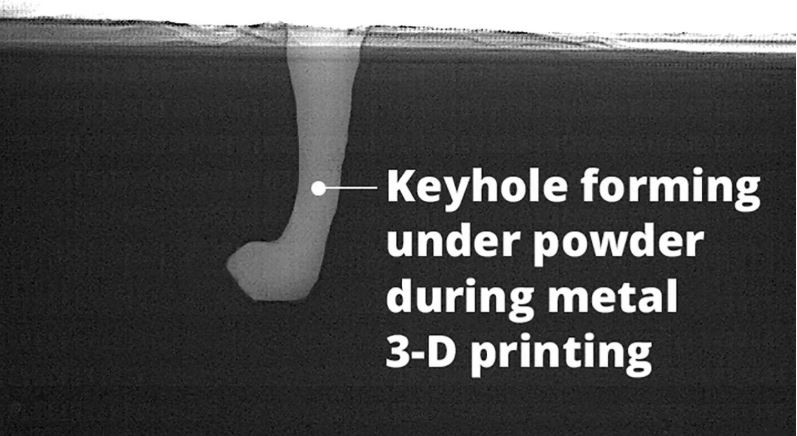
A team of researchers has identified tiny gas pockets that cause serious 3D-printing problems. They have also created a methodology to predict the formation of the gas pockets. Their research could improve the 3D printing process significantly.
The researchers, from the U.S. Department of Energy’s Argonne National Laboratory and Carnegie Mellon University, wrote about their work in the prestigious journal Science (citation below). The authors were Ross Cunningham, Cang Zhao, Niranjan Parab, Christopher Kantzos, Joseph Pauza, Kamel Fezzaa, Tao Sun, and Anthony D. Rollett.
Anthony Rollett, a Professor of Materials Science and Engineering at Carnegie Mellon University, said:
“The research in this paper will translate into better quality and better control in working with the machines. For additive manufacturing to really take off for the majority of companies, we need to improve the consistency of the finished products. This research is a major step in that direction.”
Argonne’s APS (Advanced Photon Source), DOE’s Office of Science User Facility, has extremely bright, high-energy X-rays. The researchers used the facility to take images and a super-fast video of LPBF. LPBF (Laser Power Bed Fusion) is a process in which lasers are used to melt and then fuse material powder together.
Defects form when tiny gas pockets are trapped
The lasers create the finished product from the ground up, literally. They scan over each layer of powder to fuse metal where necessary.
When tiny gas pockets become trapped in these layers, defects can form. The defects can cause cracks or other imperfections in the final product.
Manufacturers do not know much about how lasers drill into the metal, creating ‘vapor depressions’ (cavities). However, they assume that the fault lies in the type of metal powder or laser strength.
That is why manufacturers have been using a trial-and-error approach with different kinds of lasers and metals. They believe that their approach minimizes the risk of defects.
Gas pockets exist under nearly all conditions
These vapor depressions exist under virtually all conditions in the process, regardless of metal or laser types. More importantly, this latest study shows how to predict when a small depression will turn into a large and unstable one. Specifically, an undesirable gas pocket that can cause a defect.
Prof. Rollet said:
“We’re drawing back the veil and revealing what’s really going on. Most people think you shine a laser light on the surface of a metal powder, the light is absorbed by the material, and it melts the metal into a melt pool. In actuality, you’re really drilling a hole into the metal.”
By using one of the most powerful synchrotron facilities in the world at Argonne’s APS, the researchers observed what happened as the laser moved across the metal powder bed creating each layer of the final product.
Laser can change melt pool shape
The melt pool shape, under perfect conditions, is semi-circular and shallow, i.e., it is in ‘conduction mode.’ However, during the 3D printing process, the high-power laser can change the melt pool shape. It can become like a keyhole in a warded lock. In other words, large and round on top, and narrower toward the bottom.
This type of ‘keyhole mode’ melting is more likely to result in defects in the final product.

Predicting keyhole phenomenon to predict nasty gas pockets
Co-first author, Ross Cunningham, who recently completed his Ph.D. course at Carnegie Mellon University, said:
“Based on this research, we now know that the keyhole phenomenon is more important, in many ways, than the powder being used in additive manufacturing. Our research shows that you can predict the factors that lead to a keyhole — which means you can also isolate those factors for better results.”
According to an Argonne National Laboratory press release:
“The research shows that keyholes form when a certain laser power density is reached that is sufficient to boil the metal.”
“This, in turn, reveals the critical importance of the laser focus in the additive manufacturing process, an element that has received scant attention so far, according to the research team.”
Tao Sun, an Argonne physicist, said:
“The keyhole phenomenon was able to be viewed for the first time with such details because of the specialized capability developed at Argonne. Of course, the intense, high-energy X-ray beam at the APS is the key.”
Predicting gas pockets could speed up 3D printing
The authors believe their research could encourage additive manufacturing machine makers to offer more flexibility. Specifically, when controlling the devices. The improved use of the 3D printers could lead to a major improvement in the final product.
Additionally, these insights could help speed up the 3D printing process.
3D printing and additive manufacturing
3D printing involves using a 3D printer to create three-dimensional objects. 3D printers make objects using additive processes. In other words, they lay down layer-upon-layer until the final product is ready.
We call the process of starting with nothing, adding layers and ending up with something, additive manufacturing. It contrasts with subtractive manufacturing. With subtractive manufacturing, we start with, for example, a block. We chip away at the block until we have the final product.
Citation
“Keyhole threshold and morphology in laser melting revealed by ultrahigh-speed x-ray imaging,” Ross Cunningham, Cang Zhao, Niranjan Parab, Christopher Kantzos, Joseph Pauza, Kamel Fezzaa, Tao Sun, and Anthony D. Rollett. Science, 22 Feb 2019, Vol. 363, Issue 6429, pp. 849-852. DOI: 10.1126/science.aav4687.

